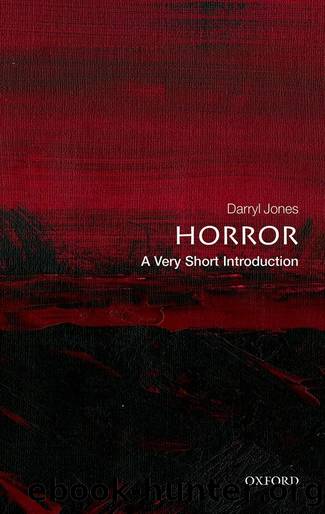Horror by Darryl Jones

Author:Darryl Jones [Jones, Darryl]
Language: eng
Format: epub
ISBN: 9780191072093
Publisher: OUP Oxford
Published: 2021-03-29T00:00:00+00:00
5b. William Blake, Nebuchadnezzar (1795).
Sometimes lycanthropy is, as Pliny maintained, a straightforward curse, a misfortune brought upon an innocent through sheer bad luck, or as a result of a family history over which they have no control. This remains a significant impetus for modern cinematic lycanthropy, in Werewolf of London (1935), The Wolf Man (1941), The Curse of the Werewolf (1961), or An American Werewolf in London (1981). Modern beast transformations have also found a powerful explanatory narrative in Darwinism, a major source of anxiety ever since the publication of The Origin of Species in 1859, as we shall see in Chapter 5. The Strange Case of Dr Jekyll and Mr Hyde (1886) and The Island of Doctor Moreau (1896) are both explicitly post-Darwinian narratives of beast transformation, and all subsequent tales of lycanthropy are in their different ways necessarily informed by the implication of natural selection that there is no existential division between Man and Beast.
In many cases, as with Lycaon himself, lycanthropy is both a punishment for and a metaphor for savagery. In serving up human flesh (the flesh of a baby; the flesh of his own child) to Zeus, Lycaon violates numerous taboos against blasphemy, unclean eating, familial ties, and the obligations of a host. He transforms into a wolf as an externalization of his own inhumanity. This is very much the interpretation for lycanthropy which the Reverend Sabine Baring-Gould offered in his influential 1865 treatise The Book of Were-wolves.
Baring-Gould was a kind of super-Victorian, an Anglican clergyman who was also an astoundingly prolific man of lettersâa novelist, an antiquary (he wrote A Book of Dartmoor, one of Arthur Conan Doyleâs sources for The Hound of the Baskervilles), a folklorist, a hymnist (âOnward Christian Soldiersâ), and much else besides. Baring-Gouldâs interest in lycanthropy dates, he maintains, from a walking tour in a remote part of Brittany, where he is warned against setting out after dark, for fear of the loup-garou, âa fiend, a worse than fiend, a man-fiendâa worse than man-fiend, a man-wolf-fiendâ.
For Baring-Gould, lycanthropy is a moral category. As well as Lycaon himself, Baring-Gould identifies as lycanthropes a number of moral monstersânotorious serial killers and cannibals such as Elizabeth Bathory and Gilles de Rais. He also associates the Berserkers with lycanthropy. These were terrifyingly savage Scandinavian warriors, apparently impervious to pain and injury, who dressed in the skins of beasts for battle: âThe berserkir were said to work themselves into a state of frenzy, in which a demoniacal power came over them, impelling them to acts from which their sober senses would have recoiled ⦠and as they rushed into conflict they yelped as dogs or howled as wolves.â Berserker (or âBersickerâ) is the name Bram Stoker chose for the giant wolf that escapes from London Zoo at the Countâs bidding in Dracula. Dracula commands wolves (âListen to themâthe children of the night. What music they make!â), and is himself a lycanthrope, referred to by the locals as ââOrdogââSatan, âpokolââhell, âstregoicaââwitch, âvrolokâ and âvlkoslakââboth of which
Download
This site does not store any files on its server. We only index and link to content provided by other sites. Please contact the content providers to delete copyright contents if any and email us, we'll remove relevant links or contents immediately.
4 3 2 1: A Novel by Paul Auster(12260)
The handmaid's tale by Margaret Atwood(7660)
Giovanni's Room by James Baldwin(7161)
Asking the Right Questions: A Guide to Critical Thinking by M. Neil Browne & Stuart M. Keeley(5598)
Big Magic: Creative Living Beyond Fear by Elizabeth Gilbert(5575)
Ego Is the Enemy by Ryan Holiday(5263)
The Body: A Guide for Occupants by Bill Bryson(4945)
On Writing A Memoir of the Craft by Stephen King(4846)
Ken Follett - World without end by Ken Follett(4617)
Adulting by Kelly Williams Brown(4462)
Bluets by Maggie Nelson(4458)
Eat That Frog! by Brian Tracy(4407)
Guilty Pleasures by Laurell K Hamilton(4339)
The Poetry of Pablo Neruda by Pablo Neruda(4016)
Alive: The Story of the Andes Survivors by Piers Paul Read(3953)
White Noise - A Novel by Don DeLillo(3935)
Fingerprints of the Gods by Graham Hancock(3922)
The Book of Joy by Dalai Lama(3879)
The Bookshop by Penelope Fitzgerald(3761)
